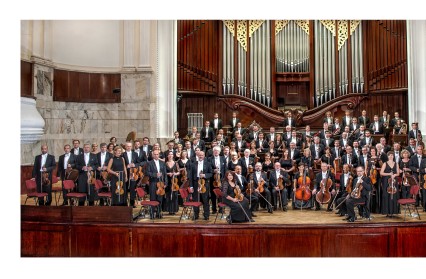St David’s Hall, Cardiff, May 19 2015
Szymanowski: Stabat Mater
Beethoven: Symphony No.9
Warsaw Philharmonic Orchestra and Chorus
Conductor: Jacek Kaspszyk
Soprano: Wioletta Chodowicz
Mezzo: Hannah Pedley
Tenor: Andrew Rees
Baritone: Paul Carey Jones
Pairing Beethoven’s hymn to humanity with Schubert’s Third Symphony, as the Warsaw Phil had done for previous concerts on its current UK tour, might have made sense to someone, but the latter’s relatively lowly place in the concert repertory must have necessitated special pleading as an equivalent.
What does convince slightly more is the programme for its final four outings – this concert being the first – in which an oratorio Szymanowski wrote when he turned to religious matters in the 1920s was coupled with Beethoven’s Choral Symphony and included the orchestra’s own chorus. Have choir, will deploy, as it were. Earlier concerts had included local choirs for the Beethoven, and one also featured Chopin’s Piano Concerto No. 1 and Mahler’s Fourth Symphony. The tightly disciplined Warsaw Chorus joined the tour for the coming together of the Szymanowski and Beethoven works.
There may have been songs and choruses with orchestra before the Choral – in opera, obviously – but even Beethoven could not have foreseen what a contribution he was making in his 9th symphony to the inspired aggrandisement of the orchestra as we have come to know it in its authoritative and gloriously flamboyant form.
Yet the Choral is not everyone’s favourite Beethoven symphony and arguably not the aesthetic culmination of his output in that genre, despite the startling union of vocal and instrumental forces. In a cynical age, the vocal outbursts can sound worthy and over-optimistic. One arch-cynic has likened them to the sort of thing one might hear from excited Boy Scouts around a camp fire – highly musical ones, of course, and with Baden-Powell listening approvingly in the shadows.
Kaspszyk’s approach to the Choral was very much ‘old school’ in that whatever ripples from period-performance practice still infect orchestras of Romantic proportion and demeanour – the upper strings in this one had ten musicians apiece and almost as many cellos – the results were not apparent. For example, the idea of the wind instruments as a self-contained ‘choir’ embedded in the orchestra but raised in profile is something that can be exploited by sticklers for historical accuracy even outside the period format, but in this context it would have been impractical and a waste of time. That said, in all ‘authentic’ versions of the Beethoven symphony cycle, the Choral is not the most convincing, and maybe the composer himself might have thought its architecture, nobility and thrust would lose nothing by being carried in a sturdier vessel.
For some obscure reason, the soloists were ranged stage left behind the first and second violins. They can be, and often are, positioned anywhere depending on the auditorium and the conductor’s predilection for heroic delivery, but here their deployment seemed bizarre; they are essentially part of the chorus, a kind of promoted foursome, and might have been heard (and seen) to better advantage directly in front of the choir. Those who’ve heard the work performed at St David’s Hall on previous occasions will recall that this is often what happens; but there are several places where they can declaim from on high. Certainly, Jones’s ‘O Freunde, nicht diese Töne!’ in Beethoven’s introduction to the Schiller ode sounded less impressive than it should be considering that it prefaces a vocal-orchestra exegesis of revolutionary import in the finale, and that was mostly to do with where he was standing. It was a not inconsiderable detail in a performance that sometimes sacrificed minutiae to the pursuit of the bigger gesture, though not in the two central movements, where subtle contrasts were heeded, or in the lusty singing of soloists and chorus. That said, the choir might have benefited from a less rigid sort of phrasing.
In an almost amusing reversal of taste, what were once perceived as the excesses of Reger, Richard Strauss and others are now partly neutralised in a post-modern accommodation of the post-Wagnerian, and regarded as nothing of the sort – well, up to a point. With the Beethoven as the main fare, anything else in this context, including a Schubert symphony that was not the Great C (and thereby a synonymous No 9 in the catalogue) had to be a makeweight. At twenty-five minutes, the Szymanowski Stabat Mater, which opened the first half, could have been that had it not shared three of the Choral’s soloists (Chodowicz, Pedley and Jones) and the Warsaw chorus; were it not a sublime reduction of the composer’s usual exoticism, and did it not elicit such an exquisite performance from all concerned, Kaspszyk sensing perfectly how the more or less stately tempo is reflected in the restricted intervals of its melodies.



 Enjoyed this article? Support our writers directly by buying them a coffee and clicking this link.
Enjoyed this article? Support our writers directly by buying them a coffee and clicking this link.







